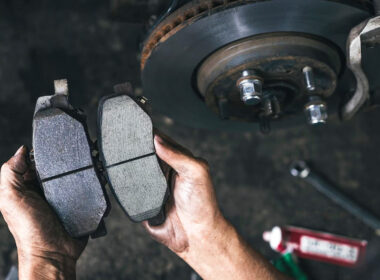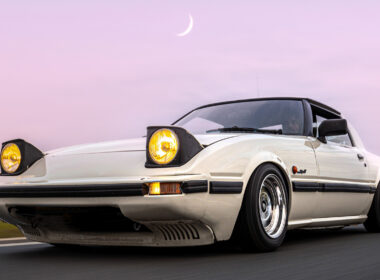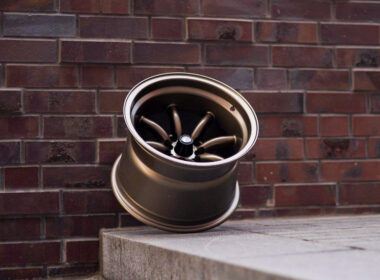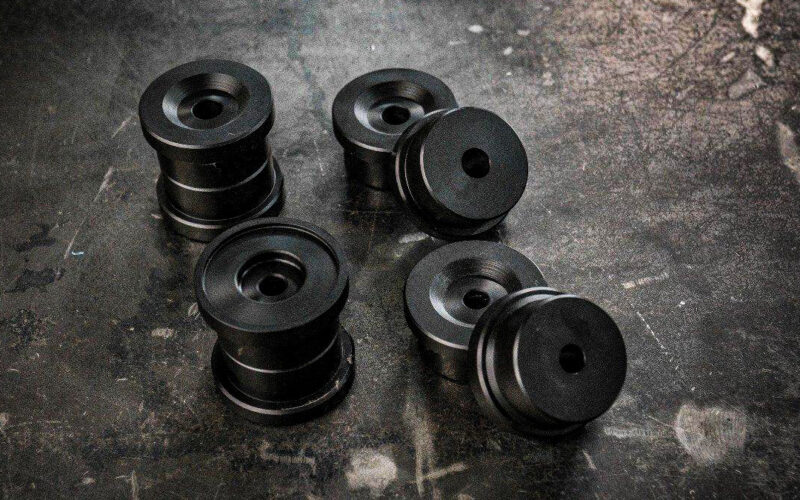Bushings are awesome; they’re the unsung heroes of automotive comfort. You could have a buttery smooth 4-cylinder engine, brand new tires, soft springs, and recently re-valved dampers, but if your bushings are kaput, your car will drive like a shaky old can of pennies.
If your daily driver has started to thud, creak, and moan more than ever, chances are that some or all of your bushings are nearing the end of their life. Replacing them is one of the easiest ways to give your car a glow-up.
Read on to know more about bushings, what they’re for, their applications, when they should be replaced, and their different types.
The Purpose of Bushings
Bushings consist of shock-absorbent elastomers encased within two cylindrical metal sleeves. They have a simple job: isolating vibrations from the chassis and preventing metal-on-metal contact between moving and stationary parts.

When this job is done right, it results in a comfortable drive, stable steering, no clunking, no unintended or abrupt changes in wheel alignment, and no premature wear on conjoint metal parts.
A lot of the reduction in NVH levels can be attributed to bushings. For those not in the know, NVH is:
- Noise: What you hear
- Vibration: What you feel
- Harshness: How much of an impact road undulations have on your ride quality
Bushings mediate the movement between many pivots and mounting points on the car’s chassis. Some of these include:
- Control arms
- Engine mounts
- Differential mounts
- Stabilizer bars
- Strut mounts
- Subframe mounts
Collectively, they insulate the car’s interior by preventing the transmission of road imperfections and engine/gearbox vibrations.

Other than lowering NVH levels and isolation of metal components, suspension bushings also fulfill the following purposes:
- Flexibility: Allowing for controlled movement and articulation of suspension components. This enables the suspension to adapt to ever-changing road conditions and maintain an optimal contact patch, which is essential for stability and traction.
- Maintaining alignment: Maintaining proper suspension angles, ensuring the wheels remain properly aligned. This is important for stability and tire wear. Damaged bushings lead to misalignment, resulting in uneven tire wear and poor steering response.
Read on to learn how bushings work and how can do the things mentioned above.
How Bushings Work

Bushings can facilitate movement between conjoint parts because of the relative motion between their elastomers and metal sleeves. This is what makes them pliable enough to maintain flexibility.
The relative motion is a result of deflection, not shear or slippage. For visual learners: imagine holding an eraser or a small silicone slab and twisting it without letting it slip between your fingers—that’s deflection.
The elastomer encased within bushing sleeves does exactly that, but much more efficiently because of their stiffness or durometer.
Understanding Durometer

A durometer is a unit of measurement that determines the hardness of an object or material and tells us how it will react to force. In this case, the material is an elastomer; it could be rubber, polyurethane, or Delrin, and the force is mostly torsion.
The word “durometer” describes both the unit of measurement of hardness and the tool used to measure it. The unit is measured across shore scales, of which there are 11. Relevant examples include:
- OO: This shore scale is used for measuring soft gels
- A: Flexible materials like silicone, rubber, and polyurethane (what bushings are commonly made of)
- D: Rigid materials like metals
Depending on the chemical composition (material) and durometer (hardness) of the elastomer used in a bushing, it will behave differently and degrade at a different pace. For instance:
- Rubber (60A to 65A): Standard issue bushings seen in almost all production cars. They’re soft and flexible, and provide ample insulation from NVH.
- Polyurethane (80A to 95A, can go up to 75D): Aftermarket bushings for high-performance applications. These are hard but flexible, and provide good performance on the track but can be difficult to live with if installed on your daily.
It’s worth mentioning that since rubber bushings deteriorate with age, their durometer will increase over time as they harden and get brittle.

A 60A rubber bushing can go up to 69A as it ages, but the same cannot be said about other bushing materials like polyurethane, polygraphite, and delrin.
The harder the bushing, the rougher the ride, and they’ll keep important parts where they’re supposed to be. But too soft around the suspension parts and they may cause the wheels to lose alignment. Examples include:
- Solid or polyurethane engine mounts will lower parasitic power loss and drivetrain flex, which means better throttle response.
- Suspension bushings of a higher durometer (poly) will prevent unwanted changes in dynamic suspension geometry by keeping the steering knuckles planted snugly where they belong.
Race cars and off-road trucks need bushings that can withstand the forces and pressures of extreme articulation. A durometer over 80A isn’t uncommon in these applications.
Bushing Replacement

Replacement of bushings is often neglected, usually by car owners who put off visiting the stealership.
We get it though, many of us prefer to take car maintenance into our own hands or rely on third-party auto shops. However, this often means fewer opportunities for periodic inspection.
If that sounds like your situation, checking your bushings should be part of your routine maintenance regimen.
They should ideally be inspected regularly as your car ages since they tend to deteriorate over time due to heat, moisture, and stress. There’s no exact mileage or duration for when bushings should be replaced though.

The best thing to do is replace them when they start to show signs of wear or damage such as:
- Pronounced noise: If you hear clunking, squeaking, or banging noises from the suspension when driving over bumps, it could indicate that your bushings are on their way out.
- Excessive vibrations: Worn bushings can lead to vibrations felt on the steering wheel and the interior. These are overly pronounced when driving over rumble strips.
- Poor handling: Steering knuckles or spindles rely on control arms to function properly. When your control arm bushings are worn out, your steering will wander and feel a bit sketchy at high speeds.
- Uneven tire wear due to altered toe angles: Bushing wear can affect wheel alignment and suspension geometry, leading to uneven tire wear.
- Steering play: Worn bushings can cause increased play or looseness in the steering, making the car feel less responsive.
Regular inspections as part of routine maintenance will help catch worn bushings before they lead to more significant issues with your suspension system. Additionally, proper installation is key.

If you intend on changing the bushings yourself, be sure to tighten them at ride height, not at full droop or full compression, otherwise, the elastomer will be in a perpetual state of deflection, leading to premature wear.
The idea is to allow the bushings to operate within the range they’re designed for. You don’t want the elastomers to twist beyond their tensile strength during normal operation.
Also, the connecting fastener should be torqued to provide the proper clamping force between the chassis and the bushing sleeve. Always replace your bushings in pairs.
Bushing Material
On to the fun stuff. Aftermarket and replacement bushings are available in a slew of different materials but we’ll only discuss the usual suspects.
Each material has its peculiar set of advantages and should be chosen based on factors like intended use, desired performance characteristics, and budget.
Upgrading to aftermarket bushings can often improve handling, ride quality, performance (marginally), and longevity, but it’s essential to consider the trade-offs in comfort, noise, and vibration.
Polyurethane

Often dubbed as the ultimate choice for high-performance applications, poly bushings are known for their high durometer, resistance to corrosion, excellent feedback, and characteristic bright red hue.
However, they’re also known for their jarring ride quality, with many enthusiasts regretting their decision and reverting to OEM rubber bushings before they can spell polyurethane.
Compared to rubber, polyurethane has a higher tensile strength and low levels of elongation, which means it’s more resistant to forces and high temperatures. This is also why they transfer far more NVH into the cabin, which is not ideal for daily-driven cars.

On the track, however, they provide excellent steering feedback and road feel which helps to improve reaction times.
But just because it’s polyurethane, doesn’t mean it’s great quality. Low-quality poly bushings exist and their efficacy depends on how they’re manufactured. That’s why it’s important to buy these parts from reputed companies.
Poor quality poly bushings are known to bind and they can be extremely noisy. The latter also applies to high-quality bushings, but that can be fixed with some Teflon tape and thick PTFE grease.
We recommend sticking to rubber bushings for your suspension peripherals and using polyurethane only for your transmission, differential, and motor mounts.
Rubber

Nearly every production car rolled off the assembly line uses rubber bushings and for good reason. Rubber is softer and more pliable than polyurethane and it does a stellar job of insulating the cabin and keeping NVH levels at a minimum.
For daily driven cars, that’s what’s ultimately going to matter. Stiff suspension with poly bushings is all fun and games when you want to have fun, but when the weekend is over and it’s time to commute or drive your family around, you’re going to have a problem.
But if you have a dedicated track car, rubber bushings might not be the best idea. Rubber wears out a lot faster than polyurethane since it’s prone to damage from elements like UV rays, heat, road chemicals, and oil deposits. No matter the durometer, these issues will persist.
A great thing about rubber bushings is how silent they are. Unlike poly bushings that have a lot to say, rubber bushings don’t squeak or squeal. This is because they’re chemically bonded with their outer shells, leaving no room for shear or slippage.
Solid Bushings
Solid bushings… People have mixed feelings about these, some say you shouldn’t install them if you want to keep your teeth in your mouth and others say they’re perfectly fine as long as you don’t put them on your daily.
The appeal of solid bushings is that they leave no room for flexion owing to metal-on-metal contact as opposed to metal on *insert elastomer*.

Since solid bushings don’t attenuate vibrations like rubber or polyurethane ones, the energy transfer between whatever components they connect is extremely efficient; no energy is lost due to damping.
They’re commonly used on transmission, engine, differential, and subframe mounts. Solid bushings for control arms exist but we don’t recommend them unless you want to read Braille off the pavement.
Solid bushings and mounts can transfer torque with minimal power loss, so using them wherever possible will result in excellent steering feedback, crisper shifts, the least amount of drivetrain flex, and better power delivery.
Which begs the question: should you install them?
We’ve heard contrasting answers on this subject. That’s probably because how much or how little people are bothered by high NVH levels and stiff ride quality is subjective.
Cursory research will give you contrasting opinions. Considering that internet communities can be a bit of an echo chamber, the best way to find out if solid bushings are for you is to drive a car with them installed. That way you can decide for yourself.
Go to car meets and track days, network, or check in with fellow enthusiasts.
Concluding Thoughts
Suspension bushings are significantly essential components that contribute to the comfort, performance, and safety of your car’s ride quality and NVH levels.
Proper maintenance and periodic inspection of bushings are important to ensure that the suspension system operates effectively and remains in good condition.
If you have any questions about replacing the bushings on your car, feel free to reach out to us. In the mean time, feel free to browse through aftermarket and OEM bushings here at Suspension Setups.




